By Krista Halling DVM DACVS
A science-backed look at your cat’s need for bonding, movement, and green time.
Not everyone landing on this website has a dog. Maybe your buddy looks like Garfield. Maybe you’ve wondered… would my cat enjoy outdoor adventures? In short: Yes. But only if we come at it from a cat’s perspective—not a dog’s.
”Cats are not small dogs”
That’s the first thing we’re taught in vet school. It’s to emphasize that cats and dogs differ in much of their physiology, preferences, needs, and tolerances. At Dogpacking.com, we’re centred on the benefits of bonding with your bestie through activities in nature. And while dogs are typically eager and adaptable outdoor partners, cats have more nuanced needs. However, when approached with the science of cats in mind, there are meaningful ways to support your cat’s well-being through connection, movement, and green time.
Connection: On Their Terms!
What cats need
It won’t surprise you that cats prefer moments of bonding and physical connection to be on their terms. Honestly, what don’t they want on their terms. Cats do form attachment to their owners that’s similar to dog-human bonds, but they often express this affection more subtly and enjoy being in charge of when and how that connection looks.
How to connect with your cat
- Offer consistent, predictable interactions (Stella & Buffington, 2013)
- Avoid forced handling or restraint, especially in unfamiliar environments (Grigg et al., 2021)
- Share quiet space—such as sitting in the sun together without demanding physical contact
- Bonding with a cat is best built through trust and autonomy (their autonomy, not yours 😉
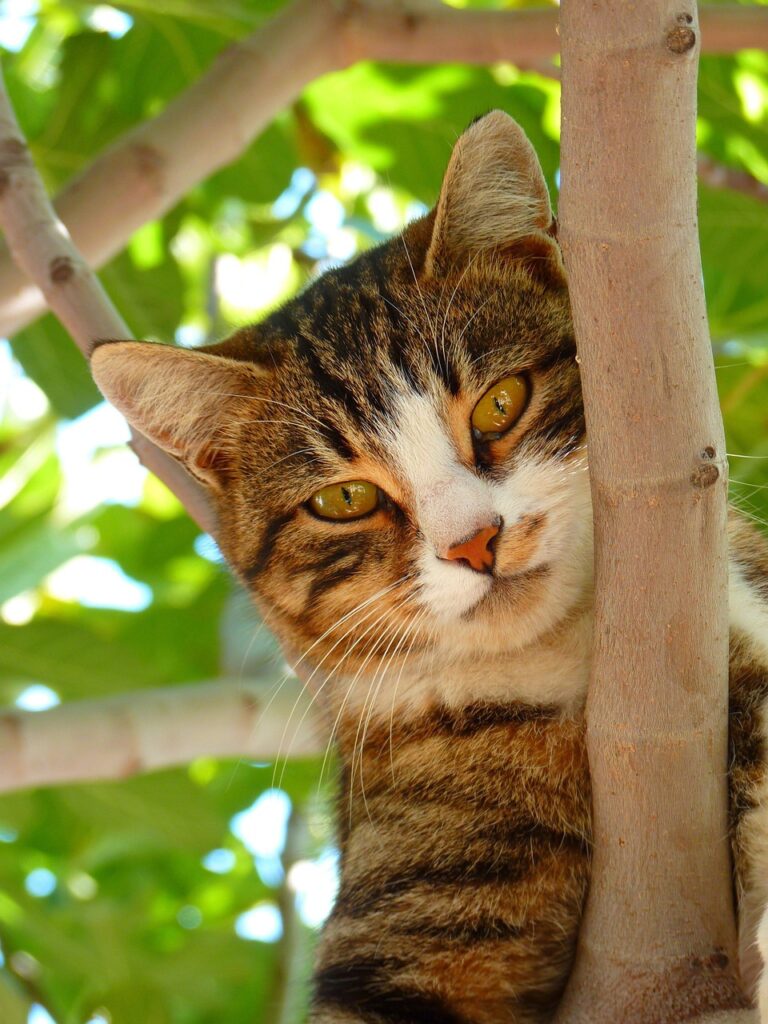
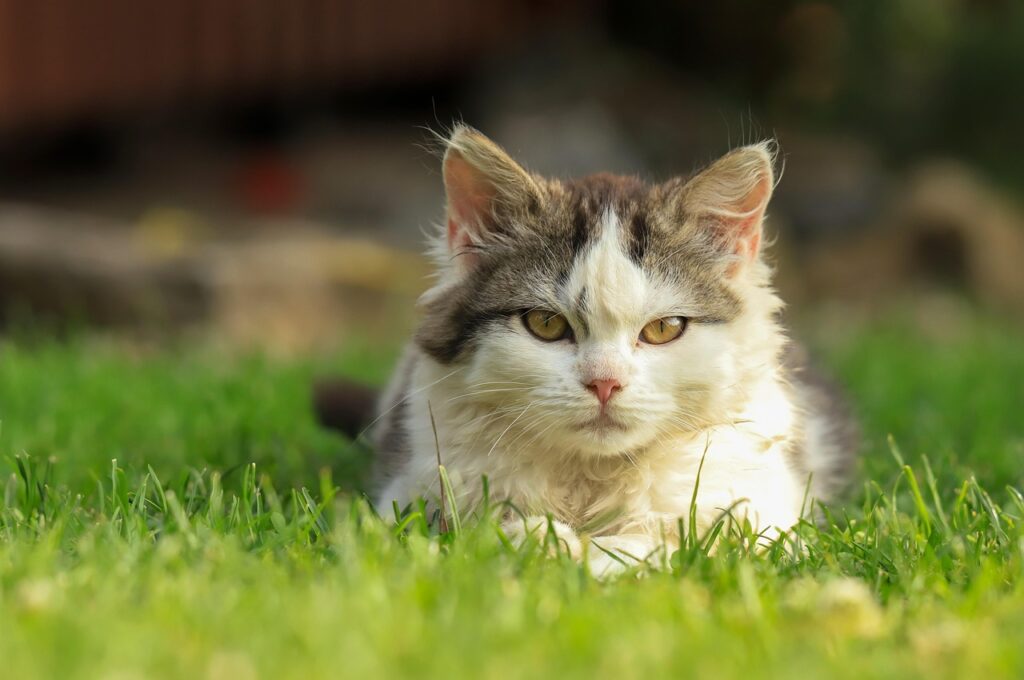
The Power of Choice: Why Agency Is Essential for Cats
Agency is an animal’s ability to make choices and exert control over their environment. For cats, this isn’t a nice-to-have—it’s foundational to reducing stress, supporting behavioral health, and improving cat-human relationships.
- Cats given control over interactions—like choosing when to be petted—have significantly lower stress scores and better behavior outcomes (Ellis et al., 2013; Gourkow et al., 2014).
- Cats housed in enriched environments with choice (e.g., hiding places, multiple resting spots) show more exploratory and affiliative behaviors (Stella et al., 2014; Kry & Casey, 2007).
- Allowing cats to initiate and terminate interactions builds stronger human-animal bonds and improves owner satisfaction (Grigg et al., 2021).
“An animal’s ability to exert control over its environment is central to its psychological well-being.” — Young (2003)
If there’s one golden rule for enriching a cat’s life, it’s this: let them choose. This is a huge gift for your cat’s wellbeing. Cats thrive when they can control their interactions, movements, and environment. Agency is related to lower stress, better health outcomes, and deeper trust between cats and their owners (Gourkow et al., 2014; Grigg et al., 2021).
How to give your cat agency
- Let your cat choose whether to engage or retreat
- Offer multiple resting and observation spots
- Allow your cat to control pacing during leash or outdoor time
- Let your cat explore their surroundings and sniff on their terms. A harness and long leash is great for this.
- Let physical contact and exposure to novel settings be on their terms
Giving your cat agency is one of the most impactful things you can do to support their mental well-being.
Physical Activity: In Microdoses
What cats need
Like dogs, cats need regular activity for musculoskeletal health, weight maintenance, and psychological well-being (Rowe et al., 2015). Unlike dogs, cats aren’t endurance animals. Their activity is naturally sprint-like and predatory in nature: short, intense bursts of energy followed by rest (Brown & Morgan, 2015). As cute as Garfield is, cat’s aren’t meant to be obese. Obesity causes as many health problems to cats as it does to humans.
Benefits of physical activity
- Reduces obesity, which affects 30–50% of domestic cats (German, 2006)
- Supports joint health and presence of lean muscle mass (Laflamme, 2012)
- Lowers risk of behavioural problems associated with boredom or frustration (Buffington, 2002)
How to let your cat be active
- Provide vertical space (cat trees, shelves) to encourage climbing (Ellis et al., 2013)
- Use toys and puzzle feeders that simulate natural prey behaviour and problem-solving (Overall, 2021)
- Offer outdoor access, ideally safe from traffic, predators or prey (e.g., catios or leash time) (Wilson et al., 2022)
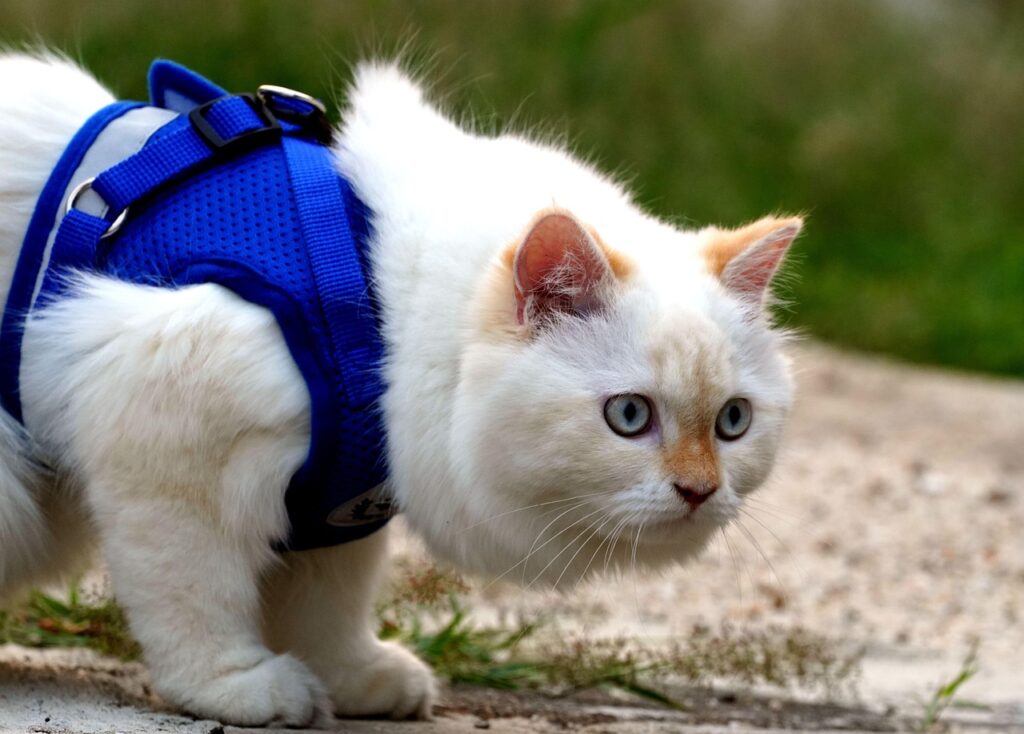
Nature and Green Time
What cats need
The feeling of grass under their paws and sun on their back. Regular exposure to natural light, airflow, and new textures can support your cat’s well-being. Environmental enrichment, especially with sensory variety, is a critical part of feline welfare (Young, 2003).
Benefits of gentle nature exposure
- Regulates their circadian rhythms via natural light (Overall, 2021)
- Provides novel scents and textures that reduce stress and support curiosity (Ellis et al., 2013)
- Increases their exploratory behavior, which is linked to improved emotional regulation (Stella et al., 2014)
Impact on birds and other wildlife
One of the most compelling reasons to leash-train your cat is the immense impact free-roaming cats have on native and migratory bird populations and other wildlife. Cats kill up to 4 billion birds per year in the U.S. alone (Loss et al., 2013). Even well-fed domestic cats regularly engage in prey activity, killing or severely injuring wild birds, chipmunks and even small reptiles and amphibians. Letting your cat explore outdoors doesn’t need to come at the expense of vulnerable wildlife.
How to give your cat green time
Sunny windows with perches or screened “catio” access
Supervised harness walks in quiet, familiar areas
Letting your cat sniff grass, bark or leaves
Green time for cats is not about the distance traveled—it’s about providing them with novelty and sensory variety in a secure, choice-driven way.
What About Indoor-Only Cats?
Not every cat—or their owner— is cut out for adventure. If your cat is strictly indoors or you live in a setting where outdoor access isn’t safe or practical, there are ways to enrich your cat’s life with nature-based experiences.
Visual and auditory stimulation can mimic aspects of the outdoors. Placing a perch or cat bed near a sunny windowsill gives your cat a place to watch birds, feel the warmth of the sun, and enjoy natural airflow if the window is open (with a secure screen, of course). Passive outdoor-like views and sounds have been shown to reduce boredom and support emotional well-being in cats (Ellis et al., 2013; Kry & Casey, 2007).
Cat TV—videos of birds, squirrels, or fish—can also provide mental stimulation, especially for cats who are prey-motivated. Controlled visual stimuli like these can enrich an indoor cat’s environment, but it’s important to prevent overstimulation or frustration by following up with real-world interaction or reward (Ellis et al., 2013).
Sensory enrichment is another powerful tool. Bringing the outdoors in with fresh herbs like catnip, silvervine, or supervised access to potted cat-safe plants like wheatgrass taps into olfactory and gustatory engagement. These enrichments can lower stress and encourage exploratory behaviors (Ellis et al., 2013; Vitale Shreve & Udell, 2017).
Movement-based play is essential. Toys that simulate prey (like wand toys or laser pointers—you can get one at the dollar store), puzzle feeders, and vertical climbing structures help indoor cats maintain physical and cognitive health (Stella et al., 2014; Ellis et al., 2013).
Finally, choice still matters. Even in an indoor environment, giving your cat a variety of options to engage with and allowing your cat to choose when to engage, where to rest, and how to interact promotes confidence and reduces stress. Agency has been consistently linked to improved welfare outcomes in cats (Grigg et al., 2021; Gourkow et al., 2014).
Takeaways for Cat Owners
Practical Ways to Enrich Indoor or Indoor-Outdoor Cats
- Sunny perches or bird-watching setups at windows
- Cat grass to sniff or chew
- Rotating toys and climbing structures for novelty
- Shared time on a porch, balcony, or secure yard—even in a carrier
- Harness sessions outdoors if your cat is willing and relaxed
- Activity sessions where you let your can chase a wand toy or laser pointer dot
For a cat, adventuring typically looks different than it does for a dog. With time and patience, some cats clearly love canoeing, camping and other outdoor activities. Knowing your own cat’s personality and needs, you can integrate agency, enrichment, outdoor time and physical activity in a way that lets them thrive.
Why Dogpacking.com Is Dog-Focused
I love all pets. And when this website was created, I toyed with adding categories for “catpacking”, “duckpacking” and even “tortoisepacking”. But as a vet, I must admit that dogs as a species are the most predictably suited to outdoor adventures: they’re social by nature and generally love both movement and novelty. That’s why Dogpacking.com is focused on canine outdoor connection.
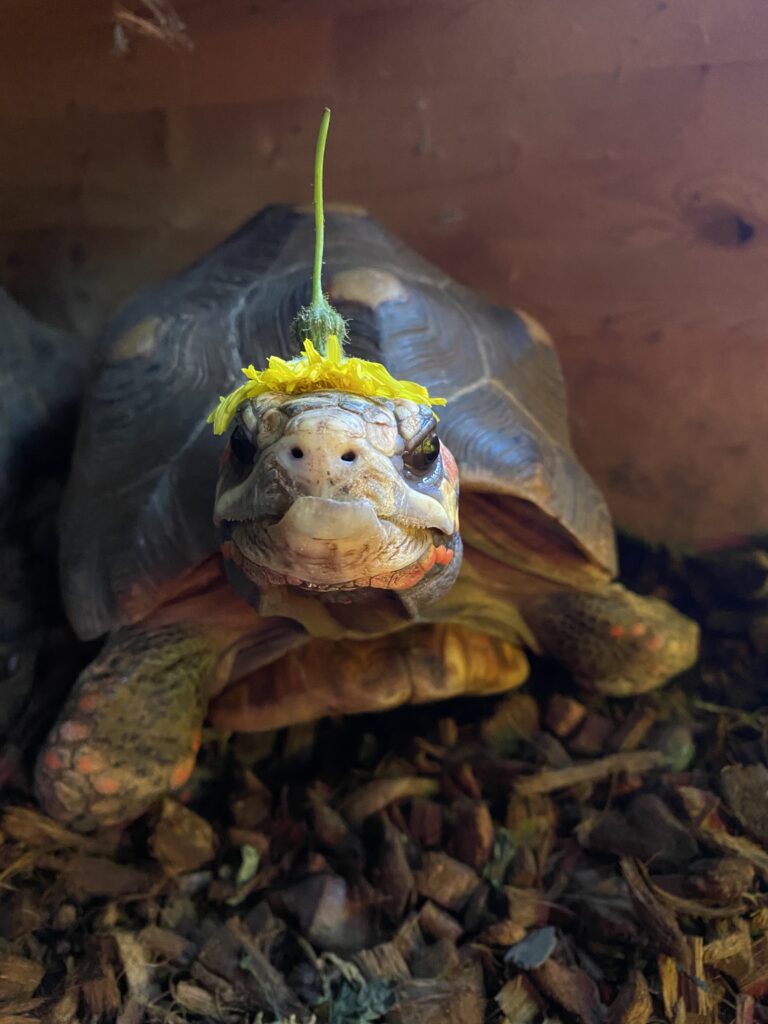
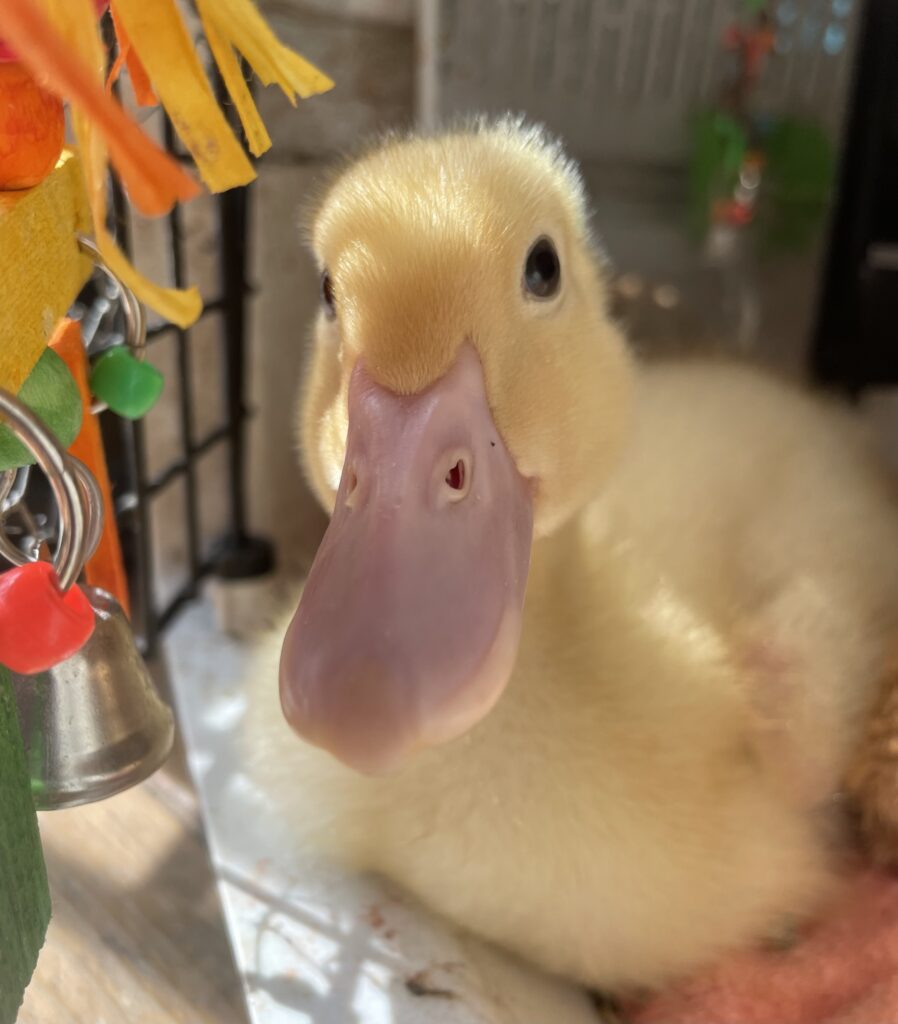
But if your best friend is a cat (or duck or tortoise) and you’ve found your way here—Welcome! We wrote this article so that you have a feline lens through which to read our other articles. Cats do benefit from bonding, green time, and movement—just more selectively than do dogs, and, of course, on their terms. 🐱💕
Related reading
If you enjoyed this article, for more inspiration check out the Summer 2025 Print Edition of Explore magazine: Meet Canada’s Adventure Cats. It’s a great read!
For more ideas on how to bond with your bestie outdoors, check out our Dogpacking 101 articles.
About the author
Krista Halling is a veterinarian board-certified with the American College of Veterinary Surgeons and creator of Dogpacking.com. She is also certified in the Human-Animal Bond and in Canine Physical Rehabilitation. Krista loves travelling and adventuring with River, her mini goldendoodle sidekick. Her duck and tortoise largely stay home.
References
- Bradshaw, J. (2013). Cat Sense: How the New Feline Science Can Make You a Better Friend to Your Pet. Basic Books.
- Brown, W. Y., & Morgan, K. T. (2015). Exercise and play behavior in domestic cats. Journal of Feline Medicine and Surgery, 17(2), 119–127.
- Buffington, C. A. T. (2002). External and internal influences on disease risk in cats. Journal of the American Veterinary Medical Association, 220(7), 994–1002.
- Ellis, S. L. H., Rodan, I., Carney, H., Heath, S., Rochlitz, I., Shearburn, L. D., Sundahl, E., & Westropp, J. L. (2013). AAFP and ISFM feline environmental needs guidelines. Journal of Feline Medicine and Surgery, 15(3), 219–230.
- German, A. J. (2006). The growing problem of obesity in dogs and cats. The Journal of Nutrition, 136(7), 1940S–1946S.
- Grigg, E. K., Pick, L., Nibblett, B. M., & Mench, J. A. (2021). Liking what they like: Respecting feline agency in veterinary care and enrichment. Frontiers in Veterinary Science, 8, 751681.
- Humphrey, T., Proops, L., Forman, J., Spooner, R., & McComb, K. (2020). The role of cat eye narrowing movements in cat–human communication. Scientific Reports, 10(1), 16503.
- Laflamme, D. (2012). Understanding and managing obesity in cats and dogs. Veterinary Clinics: Small Animal Practice, 42(4), 725–743.
- Overall, K. L. (2021). Manual of Clinical Behavioral Medicine for Dogs and Cats (2nd ed.). Elsevier.
- Rowe, E., Browne, W. J., Casey, R. A., Gruffydd-Jones, T. J., & Murray, J. K. (2015). Risk factors identified for owner-reported feline obesity at around two years of age. Preventive Veterinary Medicine, 121(3–4), 273–281.
- Stella, J. L., Croney, C. C., & Buffington, C. A. T. (2014). Environmental factors that affect the behavior and welfare of domestic cats. Journal of Veterinary Behavior, 9(5), 217–224.
- Stella, J. L., & Buffington, C. A. T. (2013). Effects of stressors on the behavior and physiology of domestic cats. Applied Animal Behaviour Science, 143(2–4), 157–163.
- Vitale Shreve, K. R., & Udell, M. A. R. (2015). What’s inside your cat’s head? A review of cat (Felis silvestris catus) cognition research past, present and future. Animal Cognition, 18(6), 1195–1206.
- Vitale, K. R., Behnke, A. C., & Udell, M. A. R. (2019). Attachment bonds between domestic cats and humans. Current Biology, 29(18), R864–R865.
- Wilson, C. H., Hemsworth, P. H., & Coleman, G. J. (2022). Human–cat interactions in the domestic home: Implications for cat welfare. Animals, 12(11), 1465.
- Young, R. J. (2003). Environmental Enrichment for Captive Animals. Wiley-Blackwell.
- Gourkow, N., Lawson, J. H., Hamon, S. C., & Phillips, C. J. C. (2014). Describing the emotional states of shelter cats: Associations with behavior, adrenocortical activity, and environment. Applied Animal Behaviour Science, 160, 94–103.
- Kry, K., & Casey, R. (2007). The effect of hiding enrichment on stress levels and behavior of domestic cats (Felis sylvestris catus) in a shelter setting. Animal Welfare, 16(3), 375–383.




Leave a Reply